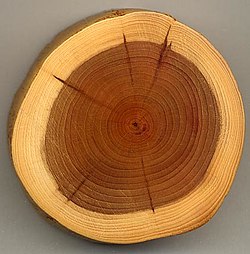
Back Hout Afrikaans Holz ALS እንጨት Amharic Fusta AN Holt ANG خشب Arabic ܩܝܣܐ ARC خشب ARZ কাঠ Assamese Madera AST

Wood is what keeps trees and shrubs upright, and what transports water from the roots to the leaves. The two main chemical substances in wood are cellulose and lignin.
Wood is formed in trees and shrubs by the cambium, a cell layer between bark and wood. The result is that wood is formed in circular rings, which are called growth rings.
The wood in the centre of the tree or shrub may have a different color from that on the outside. In that case, the wood on the outside is light in color, and is called "sapwood"; the wood in the centre is darker in color, and is called "heartwood". Most often, heartwood is more resistant to rot than sapwood. Not all trees and shrubs form heartwood, and it is also possible that heartwood differs very little in color from the sapwood, or not at all.